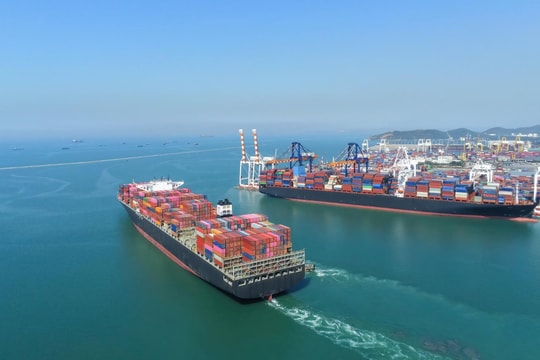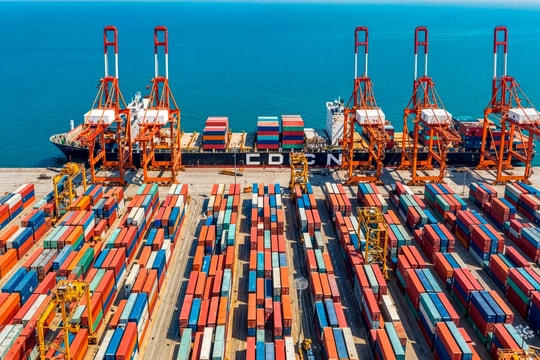Experience in operating and preventing bad debt risks
The general situation of 2022: monetary policies have been
tightened in many countries around the world. The trend of rapidly
increasing interest rates in countries caused the USD price to rise. An
increase in interest rates caused capital flows to shift and activities
to become abnormal.

They all have caused impacts to Vietnam’s monetary policy. Two times of raising operating interest rates by the State Bank have made important contribution to controlling inflation in 2022 at 3.15%, which achieved the set target. This year, the Government set an inflation target of under 4.5%.
With monetary policy management solutions implemented synchronously, in 2022, the banking sector actively contributed to the outstanding achievements of the economy. Accordingly, inflation in 2022 was controlled according to the set target, in which the average CPI inflation in 2022 was 3.15%, GDP growth reached 8.02%- the highest level in recent years. Great pressures on the domestic currency and foreign exchange markets were resolved, thereby contributing to stabilizing the macro-economy and ensuring the safety of the credit institution system.
In fact, in October 2022 the incident of Saigon Commercial Bank (SCB) strongly affected liquidity of the system and the market, SBV has focused on giving priority to supporting the system of credit institutions to solve the problems: solving liquidity management issues, clearing market sentiment and remaining issues to ensure system safety against existing risks.

By the end of 2022, credit was estimated to increase by 14.5%; money market and foreign exchange were basically stable. The VND depreciated at a low level (3.5%), the interest rate level increased by nearly 1% pa- a much lower volatility compared to other countries in the world and the region. The supply of foreign currency to domestic and foreign enterprises and foreign investors of Vietnam was guaranteed.
On February 1, 2023, the US Federal Reserve (FED) decided to raise the basic interest rate by 0.25 percentage points, to a range of 4.5 - 4.75%- the highest level since October, 2007.
The fact that FED slowed down the rate hike with a plan to stop raising interest rates in 2023 in the context of a less positive US economic outlook will help reduce devaluation pressure on the VND this year, helping VND to have more stable movements compared to that in 2022.
With pressure to support the exchange rate easing, pressure to raise interest rates is no longer in 2023, monetary policy this year is likely to shift in the direction of supporting growth. In anticipation of
this, on February 8, 2023, SBV had a meeting with many real estate corporations to discuss solutions to overcome difficulties. However, according to SBV, the credit growth target for the whole year of 2023 will be only 14-15%, in order to limit the risk of bad debt. Accordingly, strictly control credit for potential risk areas- especially corporate bond investment, investment, securities trading, and real estate (especially controlling the degree of credit concentration in a particular area, large number of customers/customer groups, large-scale projects, high-end segment) - will create favorable conditions for businesses and people to access bank credit.
According to financial statements of the fourth quarter of 2022 of 27 commercial banks, the total bad debt balance of banks as of December 31, 2022 has increased by 35% compared to that of the end of the previous year, to over VND 136,400 billion.
Priority given to controlling inflation and stabilizing the macro - economy
The year 2023 was forecast to be more difficult
as the global economy declines. The domestic
economy will also face intertwined advantages and
challenges, Vietnam's GDP growth is forecast to
slow down, but will still stand at a good level, about
6 - 6.5%. In which, export is forecasted to increase
by 8-10%, investment (domestic and foreign) will
increase by about 8%.

Inflation in 2022 was relatively low, however, Vietnam continues to witness strong inflationary pressure. December 2022 is the third consecutive month that inflation has exceeded the ceiling of 4%. Not only did core inflation increase to 5% over the same period last year, but Vietnam also witnessed an increase in raw material prices.
According to statistics, the consumer price index (CPI) in January 2023 increased by 4.89% over the same period last year. Therefore, inflation is still one of the important challenges and tasks of monetary policy this year. Vietnam has deeply integrated with major economies in the world. Therefore, domestic inflation is also under pressure from imported inflation from other countries, causing an increase in production costs. Therefore, monetary policy should remain in a cautious state but also need to be flexible to be proactive in the uncertain context.
Inflation in the first quarter of 2023 is estimated at over 5% compared to that of the same period in 2022. Besides, with China reopening its economy, world commodity prices are still unpredictable. Pressures from increasing interest rates and exchange rates are still large and will be a challenge for macroeconomic management.
Therefore, SBV's monetary policy management orientation in 2023 will be very cautious, aiming at the following goals: controlling inflation, stabilizing the macro-economy, maintaining safe and healthy stability. However, there will be many difficulties to face in management orientation in 2023 from monetary policy, interest rates, exchange rates, credit growth.... In particular, in the context of Vietnam's economy with a large openness, the total import and export turnover reached nearly 730 billion USD, equally to 190% of GDP.
SBV will continue to adopt very flexible and well- balanced policies to ensure the confidence of enterprises and people in the economy in maintaining interest rate stability as well as social stability.
In addition, it will continue to focus on providing
capital in priority areas, especially in the field of
agriculture and rural areas, small and medium-
sized enterprises, export enterprises, spare-part
manufacturing enterprises, especially serving sectors playing a driving force for the economic growth at the moments; fields of purchasing food
and agricultural products of the Mekong Delta and the Central Highlands...

Although inflation is still under control, however, pressure will continue to increase in 2023, especially core inflation which may create many challenges for inflation control in 2023, coming from supply side (pushing cost) and demand side (pulling demand). On the supply side, the second round impact from high world commodity prices in the years 2020-2022 will continue to be reflected in production costs (import inflation) and thereby affect consumption costs of other domestic goods. On the demand side, it is expected that the domestic economy will continue to recover, thereby promoting the recovery and rapidly increasing aggregate demand of the economy, putting pressure on prices.
SBV is expected to balance monetary policy to support growth, while maintaining price stability and ensuring the safety of banking operations. With the experience in 2022, it is hoped that it will continue to use the experience for operations in 2023.




.png)












